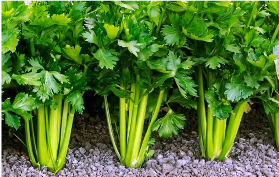From our resident food explorer Krissy Billiczky
 Celery originated in Mediterranean regions and the Middle East. The Egyptians, Greeks, and Romans grew this vegetable as an aromatic and medicinal plant.
Celery originated in Mediterranean regions and the Middle East. The Egyptians, Greeks, and Romans grew this vegetable as an aromatic and medicinal plant.
It’s claimed medicinal purposes were probably attributable to its volatile oils, contained in all portions, but mostly the seed. During ancient times Ayurvedic physicians used celery seed to treat the following conditions: colds, flu, water retention, poor digestion, various types of arthritis, and liver and spleen ailments. Woven garlands of wild celery are reported to have been found in early Egyptian tombs.
Scientific research is limited but studies suggest that celery has the following benefits:
- It is a great source of important antioxidants – there are at least 12 additional kinds of antioxidant nutrients found in a single stalk, like vitamin C, beta carotene, and flavonoids
- being a wonderful source of phytonutrients, and containing 25 anti-inflammatory compounds, it can reduce instances of inflammation in the digestive tract, cells, blood vessels, and other organs
- can support digestion
- can help reduce blood pressure
- rich in vitamins and minerals – vitamins A, K, C and also potassium and folate
- with its low glycaemic index, it has slowed steady effect on blood sugar level and 10 calories per stalk it’s been considered good to eat for weight management
- good alkalizing effect with containing minerals like magnesium, iron and sodium
- recent research found that a flavonoid called luteolin in celery may have anticancer properties — it may help prevent the spread of cancer cells and induce cell death
Celery is safe to take for most people, but the pregnant and breast-feeding ladies should avoid.
Celery can cause allergic reaction with symptoms such as hives, swelling and difficulty breathing. With any of these symptoms after eating celery, one must seek medical attention.
Celery can be found in fresh or dried herb format.
Cinnamon is a spice that is made from the inner bark of trees scientifically known as Cinnamomum.
It has been used as an ingredient throughout history, dating back as far as Ancient Egypt. It used to be rare and valuable and was regarded as a gift fit for kings.
Cinnamon is made by cutting the stems of cinnamon trees. The inner bark is then extracted, and the woody parts removed. When it dries, it forms strips that curl into rolls, called cinnamon sticks. These sticks can be ground to form cinnamon powder.
There are two main types, Ceylon cinnamon also known as true cinnamon and Cassia cinnamon, the more common widely used variety.
Scientific research is limited in some areas but there are confirmed health benefits of cinnamon:
- cinnamon is loaded with antioxidants, contains highly potent powerful polyphenols
- has anti-inflammatory properties – helps your body fight infections and repair tissue damage
- can reduce risk of heart disease – reduces cholesterol and blood pressure
- can reduce insulin resistance – a hallmark of serious conditions like metabolic syndrome and type 2 diabetes.
- can lower blood sugar levels and has powerful anti-diabetic effects
- may have beneficial effects on neurodegenerative disease – although only animal studies back up research for now
- cinnamon extract may protect against cancer – more human studies needed
- may help fight the HIV1 virus – more human studies needed
Cinnamon is safe to eat for most people in small amounts.
Eating large amount of Cassia cinnamon which contains coumarin, can cause liver damage.
If in doubt, as ever, please seek advice from a healthcare or medical professional.
Cinnamon can be found in powder or rolled cinnamon bark format as well as concentrated cinnamon oil.

